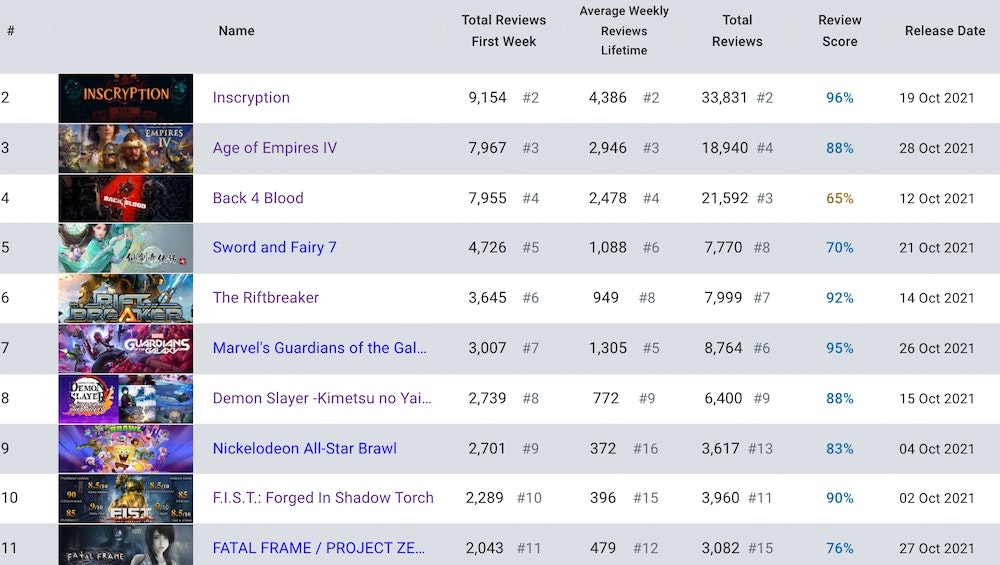How can I calculate the sales and revenue of a game on Steam based on the number of user reviews
According to gaming expert Simon Carless, the number of copies sold and the revenue of the game on Steam can be roughly calculated based on the number of user reviews. It turned out that in October, only 1.5% of the total number of new releases sold over 40,000 copies in the first seven days.Carless shared his thoughts in the latest issue of his newsletter.
As a basis for a small study, he took new games released on Steam in October.
Carless noted that 965 new titles appeared in the Valve store in just a month (interestingly, analysts from VG Insights estimated their number at 1229). From the list, he excluded one game with the most reviews — Crab Game, inspired by the “Squid Game“.In the top 10 new titles with the largest number of user reviews for the first week there were a lot of hits like Guardians of the Galaxy, Back 4 Blood, Age of Empires IV and Inscryption.
Top 10 new products in October by the number of user reviews for the first weekAccording to Carless, there are approximately 40 copies sold per user review on average.
Based on this, we can roughly calculate that:
- 65 new games (approximately 6% of the total number of titles released in October) received more than 100 reviews in the first week — thus, in theory, these titles could sell four or more thousand copies in the first seven days (excluding refunds);34 new titles (3.5% of the total number of releases) received more than 250 reviews in the first week — their sales could amount to 10+ thousand copies;
- approximately 19 new games (9% of the total number of releases) received more than 500 reviews — this equates to approximate sales of 20+ thousand copies in the first week;
- a total of 13 new titles (1.5% of the total number of releases) received over 1,000 reviews — their sales could amount to 40 thousand copies in the first week.
- Distribution of new products in October, depending on the number of reviews for the first week
Based on these figures, you can roughly estimate the revenue.
To do this, Carless took the world average price of one game on Steam — $ 15.
Thus, 65 October releases with approximate sales of four thousand copies could earn about $ 35 thousand in the first seven days after the release (taking into account the Steam commission and refunds). Thus, the average revenue of each such title for the first year can be $ 105 thousand.
34 new releases with sales of 10 thousand copies in the first seven days can earn $260 thousand a year. The average annual revenue of 9% of all October releases can be $520 thousand, and 1.5% of titles can earn an average of $1.05 per year per year.
However, with such calculations, it is important to take into account a number of nuances:
- some games may cost much more or less than the $15 announced above;the ratio of reviews to copies sold can also vary — from 1:20 to 1:60 (Carless notes that he does not yet have more accurate data);
- at the top of the list of games with the most reviews, there are many titles for ready-made IP or licenses (according to Carless, only 3-4 projects out of 13 top titles with 1000+ reviews can be called completely original games);
- 100% success in the long term can only be guaranteed by an “eternal” game, to which paid DLC and free updates are regularly released (for example, the “bagel” Skul: The Hero Slayer can sell 25 thousand copies per month on average, even two years after release).
- Given such estimates, indie developers need to remember – it’s not worth spending millions of dollars to develop their dream game.
There can be only two exceptions: if the developer has a publisher willing to invest money and calculate the risks, or if the authors of the game themselves are 100% sure that they will be able to get into a small percentage of the top games on Steam at the end of the year.
Carless himself notes that the golden mean when planning a development budget can be amounts in the range of hundreds of thousands of dollars or lower. If you spend more on creating a game, you may face risks that are not so easy to calculate in advance.


